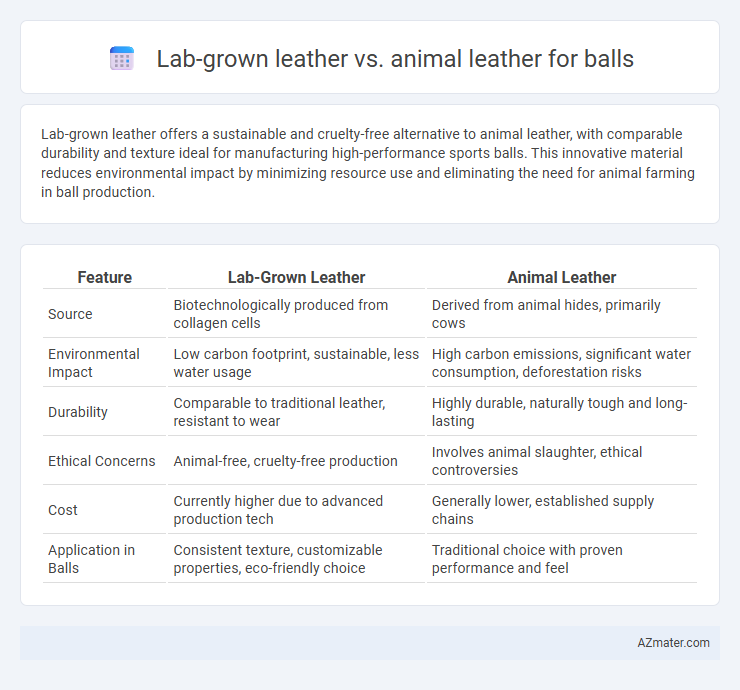Lab-grown leather offers a sustainable and cruelty-free alternative to animal leather, with comparable durability and texture ideal for manufacturing high-performance sports balls. This innovative material reduces environmental impact by minimizing resource use and eliminating the need for animal farming in ball production.
Table of Comparison
| Feature | Lab-Grown Leather | Animal Leather |
|---|---|---|
| Source | Biotechnologically produced from collagen cells | Derived from animal hides, primarily cows |
| Environmental Impact | Low carbon footprint, sustainable, less water usage | High carbon emissions, significant water consumption, deforestation risks |
| Durability | Comparable to traditional leather, resistant to wear | Highly durable, naturally tough and long-lasting |
| Ethical Concerns | Animal-free, cruelty-free production | Involves animal slaughter, ethical controversies |
| Cost | Currently higher due to advanced production tech | Generally lower, established supply chains |
| Application in Balls | Consistent texture, customizable properties, eco-friendly choice | Traditional choice with proven performance and feel |
Introduction: The Evolution of Leather for Sports Balls
Lab-grown leather for sports balls offers a sustainable alternative to traditional animal leather, reducing environmental impact through lower water usage and greenhouse gas emissions. This innovation maintains durability and performance qualities essential for high-quality balls in sports like soccer and basketball. Advances in biotechnology enable lab-grown leather to mimic the texture and strength of animal leather, marking a significant evolution in materials for athletic equipment.
What Is Lab-Grown Leather?
Lab-grown leather, also known as biofabricated or cultured leather, is produced by cultivating animal cells in a controlled environment to create a sustainable and cruelty-free material that mimics the texture and durability of traditional animal leather. This innovative process reduces environmental impact by minimizing land use, water consumption, and greenhouse gas emissions compared to conventional leather production sourced from livestock. Lab-grown leather for balls offers enhanced performance qualities such as uniform thickness and resistance to wear, making it an eco-friendly alternative for sports equipment manufacturing.
Traditional Animal Leather: Production and Features
Traditional animal leather for balls is crafted from the hides of cattle, undergoing processes like tanning, drying, and finishing to enhance durability and texture. The natural composition provides excellent grip, flexibility, and breathability, crucial for high-performance sports balls. Production involves significant water usage and chemical treatments, impacting environmental sustainability.
Durability: Lab-Grown vs Animal Leather Balls
Lab-grown leather balls exhibit consistent durability due to controlled manufacturing processes ensuring uniform thickness and resistance to wear and tear. Animal leather balls, while known for their natural strength and flexibility, may show variability in durability based on the animal source and tanning method used. Advances in lab-grown leather technology are closing the gap, offering enhanced water resistance and prolonged lifespan compared to traditional animal leather balls.
Performance on the Field: Material Impact
Lab-grown leather offers superior durability and water resistance compared to traditional animal leather, enhancing ball performance by maintaining shape and texture during intense play. Its consistent thickness and reduced porosity prevent water absorption, resulting in a lighter ball with predictable bounce and grip. Animal leather, while providing natural feel and grip, tends to absorb moisture and wear down faster, potentially compromising ball control and longevity on the field.
Sustainability: Environmental Footprint Comparison
Lab-grown leather significantly reduces environmental impact by minimizing water usage, greenhouse gas emissions, and land requirements compared to traditional animal leather production used in balls. Animal leather involves extensive cattle farming, contributing to deforestation, methane emissions, and high water consumption, which exacerbates climate change. Choosing lab-grown leather offers a sustainable alternative that lowers ecological footprints in ball manufacturing without sacrificing durability or performance.
Cost and Accessibility of Lab-Grown Leather Balls
Lab-grown leather balls offer a cost advantage over traditional animal leather balls due to lower raw material and production expenses, making them more affordable for mass-market sports equipment. The accessibility of lab-grown leather has improved with advances in biofabrication technology, enabling scalable manufacturing and consistent quality across batches. As a result, lab-grown leather balls are increasingly available through online retailers and specialty sports stores, expanding options for eco-conscious consumers.
Ethical Considerations: Animal Welfare and Alternatives
Lab-grown leather offers a cruelty-free alternative to animal leather by eliminating the need for animal farming and slaughter, addressing significant ethical concerns regarding animal welfare. This innovative material reduces environmental impact linked to traditional leather production, including deforestation and greenhouse gas emissions from livestock. Choosing lab-grown leather promotes sustainable fashion practices and supports humane treatment of animals while maintaining the durability and texture of conventional leather used in ball manufacturing.
Industry Adoption: Trends in Sports Equipment
Lab-grown leather is rapidly gaining traction in the sports equipment industry due to its sustainable advantages and consistent quality compared to traditional animal leather. Major brands are increasingly adopting lab-grown leather for manufacturing balls, driven by consumer demand for eco-friendly products and regulatory pressures on animal agriculture. Innovations in lab-grown leather technology improve durability and performance, making it a viable alternative that is reshaping market trends in ball production.
Future Outlook: Lab-Grown Leather in Sports Ball Manufacturing
Lab-grown leather offers a sustainable alternative to traditional animal leather by reducing environmental impact and ethical concerns in sports ball manufacturing. Innovations in biofabrication and material science are enhancing durability, texture, and performance, making lab-grown leather increasingly viable for professional-grade sports balls. Market trends indicate growing demand for eco-friendly materials, positioning lab-grown leather as a key component in the future of sports equipment production.

Infographic: Lab-grown leather vs Animal leather for Ball
 azmater.com
azmater.com